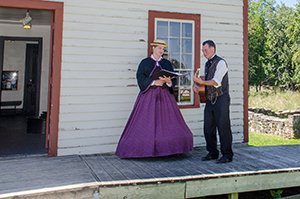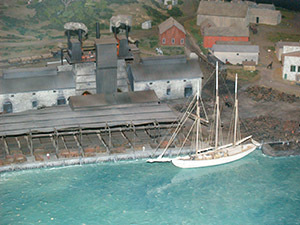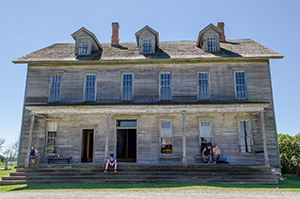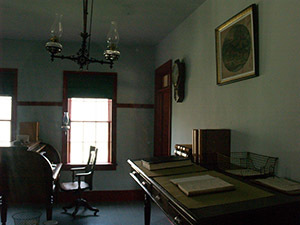Time travel in Delta County
This is part of a series of stories to mark the centennial of Michigan state parks. On May 12, 1919, the Michigan Legislature established the Michigan State Park Commission, paving the way for our state parks system. The Michigan Department of Natural Resources is celebrating this milestone throughout the year with special events, podcasts, historical stories, videos, geocaching and more. Find more details at Michigan.gov/StateParks100.
By JOHN PEPIN
Michigan Department of Natural Resources

If you take a turn off U.S. 2 at Garden Corners in Delta County and head south along M-183, the closer you get to Fayette Historic State Park, the further back in time you go.
The 711-acre park is home to a preserved historic townsite, where a late 19th-century iron-smelting community once thrived along the beautiful shoreline of Lake Michigan.
The townsite, home to iron ore blast furnaces, was named after Fayette Brown of the Jackson Iron Co.
Brown was the company agent who chose the site for the town.
“Fayette was once one of the Upper Peninsula’s most productive iron-smelting operations,” according to a park brochure. “Fayette grew up around two blast furnaces, a large dock and several charcoal kilns, after the Civil War.”
The park offers guided tours during the summertime and self-guided tours the balance of the season.
At one point, Fayette was a booming community that operated the town’s blast furnaces for 24 years, producing a total of 229,288 tons of iron.
|

The operators used wood from the area’s hardwood forests to make charcoal that fueled the furnaces. Limestone quarried from the surrounding bluffs around Fayette provided the flux that separated impurities from the iron ore.
“When the charcoal iron market began to decline, the Jackson Iron Co. closed its Fayette smelting operation in 1891,” said Randy Brown, unit supervisor at the park.
Walking the historic townsite gives park visitors a real feeling of the community, while at the same time, some of the isolation the town experienced on the Garden Peninsula.
A park interpretive display describes how stagecoaches linked Fayette with neighboring communities.
“Two Fayette livery businesses rented horses and buggies, while stage lines carried passengers to Garden, Manistique and Escanaba,” the display reads. “The overland route to Escanaba took two days; travel by boat took only three hours.”
In 1870, James Hibbert Langille described the “great changes” that had been brought about in and around Fayette’s Snail Shell Harbor, a beautiful sheltered harbor adorned with white, dolomite cliffs.
|

“The short, thick growth of cedars and white birch showed general signs of havoc,” Langille wrote. “A long dock had been constructed; several schooners had landed large quantities of building material; and houses and barns of the ruder class had been built.
“An immense smelting stack was going up; and coal pits were beginning to smoke on the sides of the hill which overlooked the harbor. The whole region echoed with the sound of axes and hammers. More men were constantly coming; and new points of work were starting every day.”
Fayette was an iron company town. Its residents depended on the town for jobs, housing, medical care and supplies, according to another interpretive display at the park.
“From 1867 to 1891, the furnaces at Fayette produced high-quality charcoal iron for America’s steel industry and supported a bustling immigrant community of nearly 500 residents,” the display reads.
Today, more than 20 structures, including the furnace complex, a three-story hotel, townhall and employees’ homes, recall the daily life of this industrial community. The park visitor center features a large, glass-encased model of the townsite.
In 1916, Jackson Iron Co. successor Cleveland-Cliffs Iron Co. sold Fayette to a couple of local businessmen who ran the hotel as a summer resort into the 1940s, according to park literature.
For years, the harbor, docks and warehouses were used by commercial fishermen. The state of Michigan acquired Fayette as a state park in 1959.
|

“In addition to the historic townsite, the park features boating and fishing in Big Bay de Noc,” Brown said. “The recently reconstructed pier with 15 modern slips offers boat camping in Snail Shell Harbor.”
In 2016, the newly constructed boat dock at Snail Shell Harbor was opened in late summer and in autumn, a modern restroom building located at the park campground was constructed.
Improvements at the site, which offers boating access via the harbor to Lake Michigan, include complete replacement of the old dock with a new floating dock system. The new dock has seven finger piers: one that is 38 feet long, two that are 45 feet long and four that are 60 feet long.
The park also offers about 5 miles of hiking trails and a beach day use area at Sand Bay. On the second Saturday of August, the park is transformed back to its glory days with period displays, food and music during the annual Heritage Day event.
Additional activities at the park include history programs, geocaching, mountain biking, swimming, paddling and interpretive programs. Facilities include a lodge, a picnic area with a picnic shelter, a modern camping area with just over 60 sites, and a visitor center, which includes a gift shop.
State-managed facilities located nearby include a state forest rustic campground at Portage Bay, with 23 sites, the 2.25-mile Ninga Aki Pathway and the Indian Lake Pathway, which is located northwest of Thompson, and winds for 9 miles through the Schoolcraft County woodlands.
Whether it’s for a day or a week, a trip to Fayette Historic State Park provides a fascinating glimpse into life in an Upper Peninsula iron-smelting company town during the latter days of the 19th century.
The winds are light and warm off Lake Michigan, the summer days inviting and the old Fayette townsite remains ready and waiting for visitors.
|
Check out previous Showcasing the DNR stories in our archive at Michigan.gov/DNRStories. To subscribe to upcoming Showcasing articles, sign up for free email delivery at Michigan.gov/DNR.
/Note to editors: Contact: John Pepin, Showcasing the DNR series editor, 906-226-1352. Accompanying photos and a text-only version of this story are available below for download. Caption information follows. Credit Michigan Department of Natural Resources, unless otherwise noted.
Text-only version of this story.
Campground: Campers enjoy an afternoon in the campground at Fayette Historic State Park.
Harbor: Boaters ply the waters of Lake Michigan from the Snail Shell Harbor.
Interior: A restored interior at Fayette Historic State Park in Delta County.
Lakeshore: A view of the Lake Michigan shoreline at Snail Shell Harbor at Fayette Historic State Park.
Model: Part of a model display depicting the Fayette townsite is shown.
Reenactors: Reenactors help make the townsite at Fayette Historic State Park come alive.
Townsite: A park visitor walks through the townsite at Fayette Historic State Park.
Visitors-1: Park visitors take pictures and tour the grounds at Fayette Historic State Park in Delta County.
Visitors-2: Park visitors enjoy the porch at Fayette Historic State Park in Delta County./
|